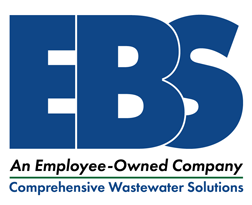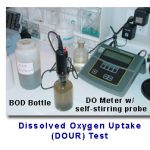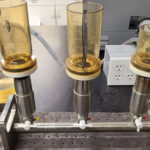It is generally accepted that aerobic biological treatment systems are robust and stable to the extent that eight key growth pressures are controlled:
- Organic Loading (BOD or COD)
- Dissolved Oxygen
- Temperature
- pH
- Nutrients
- Retention Time
- Inhibitory or toxic compounds
- Biomass — Amount, Activity, and Viability
The traditional tools and techniques for assessing biomass health focus on parameters that are generally easy to measure, such as BOD removal, MLSS/MLVSS ratio, SVI, and oxygen uptake rates. These are relatively simple, rapid, inexpensive, and have a well-developed history in the industry. These parameters do not reveal much of what is happening at the cellular level and in many cases of poor treatment plant performance, other tools and techniques are needed to diagnose and correct certain types of problems.
Poor bacterial metabolism and bioflocculation almost always manifest as poor BOD and/or TSS removal. Relying on traditional tools, data, and concepts to diagnose and correct these problems is a frustrating and oftentimes fruitless exercise. The accumulation of toxic or inhibitory compounds and the failure to produce the right type and amount of exocellular polymeric substances (EPS) are common causes of poor wastewater treatment system performance.
EPS is the biological glue responsible for floc formation and subsequently liquid/solids separation in the secondary clarifier of an activated sludge system or the quiescent zone of an aerated stabilization basin. Solids separation is the Achilles heel of most suspended growth systems. A failure at this level manifests as elevated effluent TSS in most cases, and elevated effluent BOD in some, due to the fact that biological TSS contains BOD, nitrogen and phosphorous in the cell mass. In addition to BOD and TSS issues, biologically impaired systems experience acute toxicity with greater frequency.
When a system is suffering from biological impairment, some traditional parameters, including the F/M, MCRT, MLSS/MLVSS ratio, and oxygen uptake rate (OUR), are not particularly helpful because they do not reliably measure the viability and health of the biomass. For example, the volatile fraction of the biomass does not reveal important details, such as the part of the total MLVSS that is inactive and/or non-viable. Dead cells are volatile but not viable (unable to reproduce). Active cells respire but may not reproduce (low viability). A significant fraction of the measured VSS may, in fact, be pulp fiber and have no biological function at all.
Traditional MLSS and MLVSS measurements may grossly misrepresent the biological fraction and lead to errors in calculations for critical process parameters, such as F/M ratio, yield, or MCRT. Active cells respire (consume oxygen measured as OUR) but may be unable to harness energy efficiently enough to reproduce and/or produce the exocellular polymers required for flocculation. Many chemicals used in a mill have the potential to disrupt cellular metabolism in this way, a condition known as futile cycling or uncoupling. During futile cycling, respiration rates appear to be normal, yet ATP generation is low. Adenosine triphosphate, or ATP, is the energy currency of bacterial metabolism. With ATP production and utilization, bacteria cannot reproduce, resulting in an unhealthy population.
Aerobic bacteria contain 1-2 mg ATP/g VSS. Healthy biomass turns this ATP pool over very quickly, typically at a rate of 150-400 mg ATP/g VSS/ hour, or 5-10 times the rate of oxygen uptake. An ATP: OUR ratio below 5.0 indicates that uncoupling may be occurring. Symptoms of uncoupling include poor flocculation, low biomass growth, high nutrient residuals, and normal to elevated oxygen uptake rate.
Diagnosing inhibition or uncoupling is one thing. Correcting it is another. These problems are seldom solved within the fence line of the wastewater treatment plant. More commonly they are solved at the other end of the pipe, within the mill, at the point where the problem chemical enters the sewer. Chemicals that have been found to cause metabolic problems include surfactants, terpenes, phenolics, quinones, chelants, quaternary amines, and biocides, among others.
Operators understand and make every effort to control the eight key growth pressures that affect the biological health of their system, but there is no adjustment of pH, temperature, nutrients, retention time, MCRT, or F/M ratio that can overcome the damage caused by certain chemicals at the cellular level. Source control is the only feasible solution.
Understanding biomass health, growth pressures, and in particular, toxicity and inhibition are important due to the fact that the wastewater generated by most mills contains many potentially inhibitory compounds. The following may further compromise biological stability:
- Extreme variability in loading or inadequate equalization.
- Spills, leaks, and pH/conductivity events.
- Outage-related events include sudden changes in BOD (food) loading and F:M ratio.
- Seasonal temperature changes, especially in northern climates.
Determining the relevance and role of chemical inhibitors represents a significant operational challenge. When biological health is impacted to the degree that it manifests as inhibition, uncoupling, poor settling, deflocculation, poor BOD removal, or poor TSS capture, special testing is required to determine which compounds are present and potentially causing impairment. Biomass accumulates compounds as a function of sludge age (bioaccumulation). Depending upon the health of the biology and a compound’s degradability, inhibitors may never “cycle up” to the point that the inhibitory threshold is reached. On the other hand, many systems have seen progressively deteriorating performance as various inhibitors accumulate. The diagnosis and correction of chemical inhibition require a comprehensive evaluation of mill sewers and chemical sources.
By utilizing advanced techniques for assessing biological health, the specialists at EBS can help to diagnose and correct the root causes of poor treatment. The new techniques overcome some of the limitations of traditional approaches while providing a platform to engage a broader cross-section of the manufacturing plant in improving wastewater system performance.
For more information, please free to contact EBS at info@ebsbiowizard.com or 985-674-0660.





